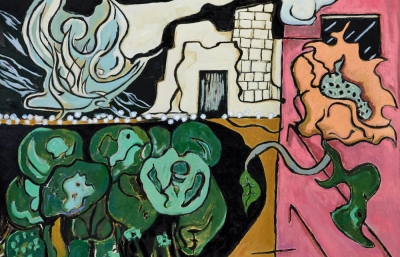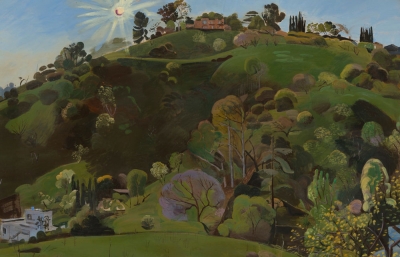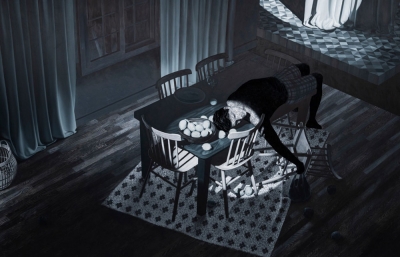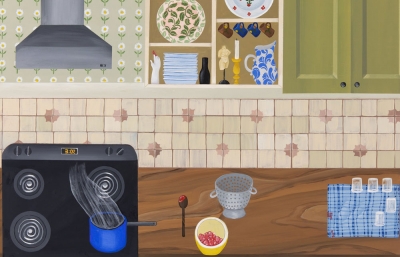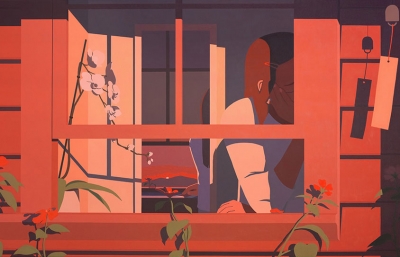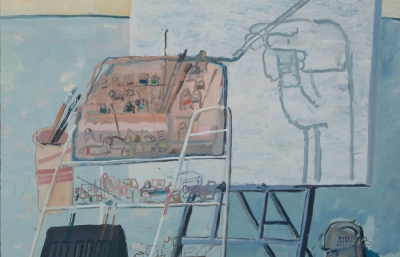When I moved to New York City a few years back, I suspected that among the clusters of repurposed warehouses in North Brooklyn, there might exist the same type of camaraderie that has driven great art movements of the past. I had heard of a group of young painters developing figurative and narrative works that utilize the rich history of oil painting, and whose friendships intersected over studio visits and the casual sharing of secret techniques and inspirations.
My quest to find them was perhaps the quickest treasure hunt of all time. Upon inquiry, I was directed a mere two blocks from the L train, to a neighborhood sometimes referred to as East Williamsburg, Bushwick, or Morgantown, into a yellow-bricked, block-wide building, up a metal staircase and down a long Kubrickian hallway. And there, hiding in plain sight, was Adam Miller.
Adam’s studio, with every inch of its 14-foot walls covered in towering canvases, reminded me much more of vertiginous Manhattan than the desolate industrial surroundings of Bushwick. Adam’s paintings also contain a nearly unbelievable intertwinement of figures in condensed spaces, a quality rarely found in today’s narrative figurative revival. And he conveys historical events of the not-so-distant past as though they were timeless mythological tales. Perhaps this is because he has never hesitated to tune in and meet minds with the Old Masters, gathering inspiration and direction transcendent of the spatial and temporal world around him. In paintings by Rubens, for example, Adam found the Baroque spiral, a compositional technique that he has used to compose four hundred years of Quebec history for a 10 x 11-foot painting commission. This painting incorporates recent protest events at the base of the painting, which rise up to Quebecois political figures, and trails off into clouds containing Tiepolo-like images of the earliest settlers of the region.
I recently visited Adam and and his wife, Alexandra, at their home in bear country to catch up and stoke him into elegant rants.
Read this feature and more in the October 2016 issue of Juxtapoz Magazine, available here.
David Molesky: When did your extensive and rich education as an artist begin?
Adam Miller: When I dropped out of high school at age 14. My father was cool about it, but my mother really freaked out. It took them six months to realize that I wasn’t going anymore. I stayed home to draw comics because I really wanted to be an illustrator. I stumbled upon the cast collection at the Pacific Northwest College of Art in Portland, which had many of the great Greek and Roman statues. Then I fell in love with Michelangelo’s work when I saw a calendar with images of the Sistine Chapel ceiling. I knew this was it. I was reading gothic and medieval literature and John Ruskin, who inspired me to go outside to try and draw foliage as perfectly as Albrecht Durer. After that, I felt culturally unfit for high school.
I would take drawing and painting classes twice a week from a convicted bank robber. He had invented some interesting techniques with acrylic paint by carefully studying books in the prison library and experimenting on his own. He’d take big brushes and crosshatch on bed sheets to make canvas texture. He would say, “You gotta get your main lines on there in 30 seconds,” like some macho old cowboy. I already had the background in comics, anatomy and perspective, but he is the guy who introduced me to a lot more. I had started copying comic books and memorizing muscles when I was 11 and got into perspective drawing a little later. I was alone in my interests. I thought I knew everything, and when other artists would tell me to look at modern art, I’d tell them to go to hell.

Portrait by Alexandra Pacula
Sounds like you were a tough kid.
I haven’t been in a fistfight in a while.
You’ve been in fistfights?
Yeah, in school, yeah. They sent me to anger camp where I got to meet Muhammad Ali, which was a great reward for a bad kid.
So I take it you’ve always marched to the beat of your own drum?
Absolutely, and good things came out it. I had a decent portfolio for a kid my age, and I was accepted into the New York Academy, the Florence Academy, and Chicago Art Institute. I chose Florence. I was 15. I was so inspired by Michelangelo that I grew a big beard, stopped bathing and just drew. I became about 30 pounds overweight because I never left the house. I just drew. The only time I left was to draw nature studies. The Italian lifestyle is the best, it showed me what good food is, but I never learned to paint there. I was always ditching class to copy work in churches. I so disliked the way that they taught painting that I had no interest in going any further with the program, so I left when I was 18 years old and went my own way painting like that for years.
You seem perfectly at home with oil paint now. How did that happen?
When I moved to New York in 2006, I felt I really wasn’t getting what I wanted and I didn’t know enough. So, I signed up for the five-nights-a-week classes with Nelson Shanks at the Art Students League, my first serious oil painting class. I actually lived in Paterson, New Jersey, so I’d take the bus into Manhattan. At the time, I was also trying to get a show together. It was a really terrible show because I was trying to do what I did before while also trying to integrate Shank’s lessons, which I never fully got because I was too cheap to buy the full set of colors. Everything involved exotic brightly colored cadmiums of every shade under the sun.

Was his goal to poison his students and make them insane?
Shank had studied with Pietro Annigoni in Florence, so he had solid drawing skills. He also worked with Henry Hensche, a well-known colorist. We would basically do sketches after sketches, with a palette loaded with copious amounts of bright colors. At one point, a visiting friend convinced me to check out a demo by Steven Assail. The way he pushed color into color on the canvas to sculpt form made sense to me. A lot more sense than the process of applying patches of color that was taught to me in Florence, and that whole objective of flattening what you see; that just seemed counterproductive to my own goals. Around this time, I finally decided to move into the city after I got stuck in a riot.
What was the riot about?
Not a clue. I got off the bus in Paterson at midnight and there were gun shots going off and police everywhere. I didn’t know neighborhoods that bad existed anymore. The cops told me to go sit in the deli. When things quieted down, a cop told me, “As long as you don’t make eye contact with anybody, you will probably make it home safely.” That was my impetus, among other reasons, to move into the city.
What made you choose Bushwick? Did you feel significantly safer in an industrial wasteland than in New Jersey?
In typical young-artist-in-New-York fashion, I picked the closest neighborhood to Manhattan with affordable studio space. It was the best move I ever made. So many artists had exactly the same idea, and I realized those grim industrial studio buildings were filled with talented painters. I would come across an artist on the internet or in a magazine and might end up bumping into them in the deli, or meeting them at an event or at a friend’s studio. This really helped my work evolve and develop. There is nothing like seeing an artist’s serious studio practices to learn and to realize how much more is possible.
And it’s true that you often use your friends in your paintings? Tell me about that process.
My paintings tend to be moments of great drama and conflict. In order to realize this conflict visually, I found it to be very important to develop a relationship with my model. They become my actors and we need to develop a good rapport and a sense of understanding. They need to understand what I want, and I need to understand what they are capable of showing. I found that by painting my friends, I am able to bring out more of them and they are able to give more because they know what I like and want in my work. I notice this with film directors, as well, who keep returning to the same group of actors. Painting is an artificial reality. What communicates in the real world has time to unfold. In painting, it must tell its story in one image.
How much of the story do you already have in your head before you start a painting?
With every painting, there is an idea that initially motivates. But for me, the painting has to surpass the idea. If the painting is just the idea, than you were probably better off just writing it down. I don’t really give a shit about the idea once I start the painting. Sure, the idea is important in that it underlies a lot of the decisions that I make. For example, I have this battle painting I’m working on now, and that’s always on my mind. This is a battle painting, but I take it very loosely, because a battle is a metaphor for what it is to be a human struggling; in the end, every battle comes down to what it is to survive. For me, that’s what a painting is, that epic timeless dialogue of what it is to be human. It’s either that, or it’s nothing. It’s disposable, it’s fashion. And if it’s fashion, it doesn’t need to be in a museum, and it doesn’t need to be in a gallery. Put it in a boutique and sell it off.

That is a huge responsibility.
Absolutely. As painters, we are standing on the shoulders of giants. So much has come down to us. And we need to give something back. And if we don’t, what the fuck are we doing? I look at all these artists I admire, and their huge bodies of work, the quality, the complexity of the narratives, all the epic things they produced. I am still going down that road. I still want to make my Sistine Chapel. That takes an awareness of the whole picture of humanity—the good, the bad and the ugly, and finding that which will continue to have value and is not simply stuck in the moment of what people think is important now. You are making it for the ages. You are connected to this tradition that goes back millennia, and you are taking it a step further and giving it to the future.
What would you say is the key to transcending time?
Honesty. Have you ever noticed that when you walk into the Metropolitan Museum, suddenly everything is okay? It’s honest, it’s real. Suddenly you are in this world of paintings and sculptures that are about beauty, ambition, failure, tragedy, comedy, love and lust. And it’s a full human picture. You don’t get that on TV. Sure, they try, Game of Thrones is kind of fun, but you don’t get it. This is especially important now in a digital world of Facebook and Twitter and all this virtual reality. Everyone is presenting a public persona for the majority of their day, and it becomes vital to connect back to the reality of what it is to be human, what it is to struggle, what it is to fear, what it is to doubt, what it is to hope. All of it is embodied in these paintings, stories, myths and portraits.
How would you describe your technique?
I started out with a surrealist sense of imagination and but then I got into the careful study of nature and creating light effects with subtle paint handling. I am deeply interested in the mannerists, particularly Michelangelo and Pontormo. I found that the contemporary artists I was drawn to were mannerists also, like Odd Nerdrum and John Currin. Their figures are not photorealistic but are believable in paintings. This is a key for me. I want figures to be more than real. Paintings copied directly from photographs seem stiff when compared to the rhythm and emotion of Greek statues, or to Michelangelo and Pontormo. This led me away from realism and into the idea that I needed to create my figures like I did when I was first starting out, and then use what I learned painting from nature to make the viewer believe them. Suddenly I could bring back those spirals and curves and angles that made the classic figures live. I found that by emphasizing the big curves of a pose, the figure would move you like flame through the painting. By emphasizing the structural horizontals, your eye would move slowly across a figure and it would become heavy. This opened up the music of the human form to me.
----
Originally published in the October 2016 issue of Juxtapoz Magazine, on newsstands worldwide and in our web store.










